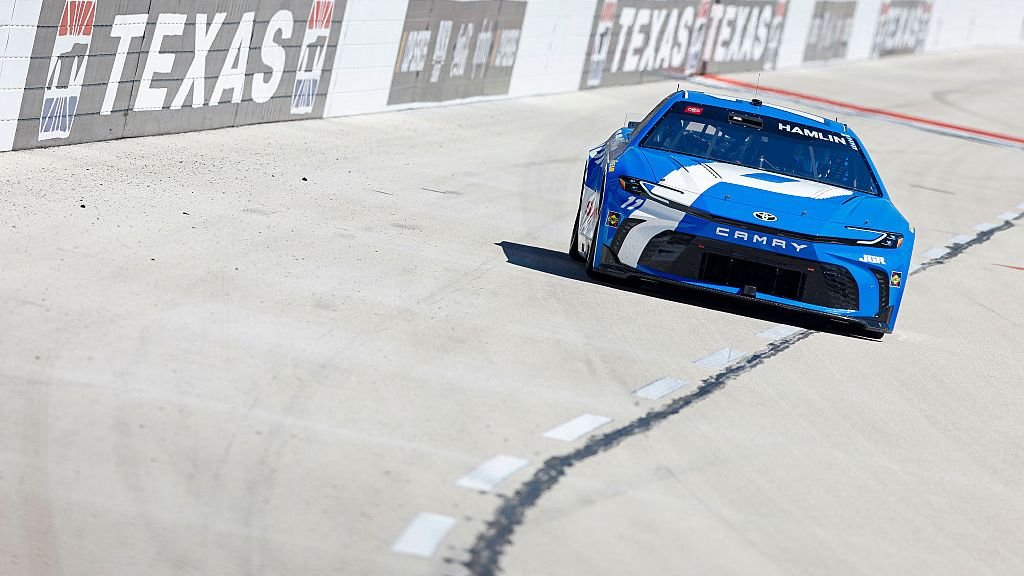Denny Hamlin experienced an unexpected and early exit during the race at Texas Motor Speedway on Sunday, as his Toyota’s engine failed spectacularly and caught fire. The incident forced Hamlin to withdraw from the competition on lap 75, just as the first stage was nearing its conclusion. The series of events unfolded rapidly: Hamlin sensed trouble when he suspected his engine was on the verge of failure, and soon after, his team noticed smoke emanating from the vehicle. This alarming situation escalated quickly, resulting in flames erupting from the left side of his Joe Gibbs Racing car as he struggled to regain control after spinning out on his own fluids before coming to a halt.
After the incident, Hamlin reassured fans that he was unharmed. The fire in his No. 11 Toyota was alarming, but fortunately, he was safe. In the aftermath, he reflected on the ongoing engine troubles that have plagued various manufacturers throughout the racing season. Hamlin noted, “I’m not really sure,” when discussing the engine issues that have affected multiple teams. He lamented the fact that he has experienced engine failures for two or three consecutive seasons, a stark contrast to earlier years when such problems were virtually nonexistent. He speculated that the drive for increased performance might be contributing to these mechanical failures. “We certainly feel like we need to get a bit more power, but this was unexpected for us,” he added.
Prior to the engine failure, Hamlin was positioned in the middle of the pack. Unfortunately, a breakdown in communication regarding pit strategy during a caution on lap 21 hindered his team’s performance. Radio communications became muddled, leaving Hamlin uncertain about the pit call. As the cars approached Turn 3, he had to request clarification multiple times. In the chaotic exchange, he finally caught the code word “cowboy” after several attempts, leading him to stay on track. Regrettably, this decision meant he was the only driver who opted not to pit, which put him at a significant disadvantage. When he finally came to pit road before the race resumed, he found himself running outside the top 20.
The engine failure caught him off guard, arriving with little warning. Reflecting on the moment, Hamlin remarked, “It was blowing up for about a lap or so before it really detonated.” He attempted to keep the car under control to prevent a complete engine failure, hoping to preserve the vehicle for diagnostic purposes. “I tried to keep it off to keep it from fully detonating, that way they can diagnose exactly what happened to it,” he explained. While the exact cause of the engine failure remains unclear, Hamlin expressed confidence that his team would investigate the issue thoroughly and should have answers in a few weeks.
This incident at Texas Motor Speedway underscores the unpredictable nature of NASCAR racing, where mechanical failures can dramatically alter the course of a race. Hamlin’s experience serves as a reminder of the challenges drivers face, not only on the track but also with the reliability of their vehicles. Engine issues are not uncommon in the world of racing, and as teams push for higher performance, the risk of failure increases. The balance between maximizing speed and ensuring reliability is a constant struggle for teams and manufacturers alike.
As the season progresses, teams will be keen to address these mechanical shortcomings. The emphasis on performance can sometimes lead to unforeseen consequences, as highlighted by Hamlin’s misfortune. Each race presents an opportunity for teams to learn and adapt, and the insights gained from such incidents are invaluable for future preparations.
For fans, moments like Hamlin’s engine failure bring to light the intricacies of NASCAR racing. While the excitement of speed and competition draws viewers in, the behind-the-scenes challenges can often be just as captivating. The technical aspects of the cars, the strategies employed by teams, and the communication between drivers and their crews all play a crucial role in determining the outcome of a race.
Hamlin’s situation illustrates how critical it is for teams to maintain clear communication, especially during high-pressure moments. The ability to convey information swiftly and accurately can make the difference between a successful pit stop and a costly mistake. As the season continues, expect teams to focus on refining their communication processes and enhancing their vehicles’ reliability.
In the wake of this incident, fans and analysts alike will be closely watching Hamlin and his team. The resilience and adaptability of drivers and teams in the face of adversity are what make NASCAR so compelling. Each race brings its own set of challenges, and how teams respond to setbacks will undoubtedly shape their performance in the remainder of the season.
Looking ahead, Denny Hamlin and Joe Gibbs Racing will undoubtedly analyze the failure to ensure it does not recur. The racing community thrives on competition and the drive for excellence, and Hamlin’s determination to overcome these hurdles will be a focal point for fans. As the team investigates the root cause of the engine failure, there’s a sense of anticipation about how they will rebound in future races.
In conclusion, Denny Hamlin’s early exit from the Texas Motor Speedway race due to an engine failure is a stark reminder of the unpredictable nature of NASCAR. The combination of mechanical issues and the importance of communication within teams highlights the complexities of the sport. As the season unfolds, the focus will remain on how teams manage these challenges and strive for improved performance on the track. Fans can expect an exciting season ahead as drivers like Hamlin continue to push the limits of their machines while navigating the intricacies of racing dynamics.
